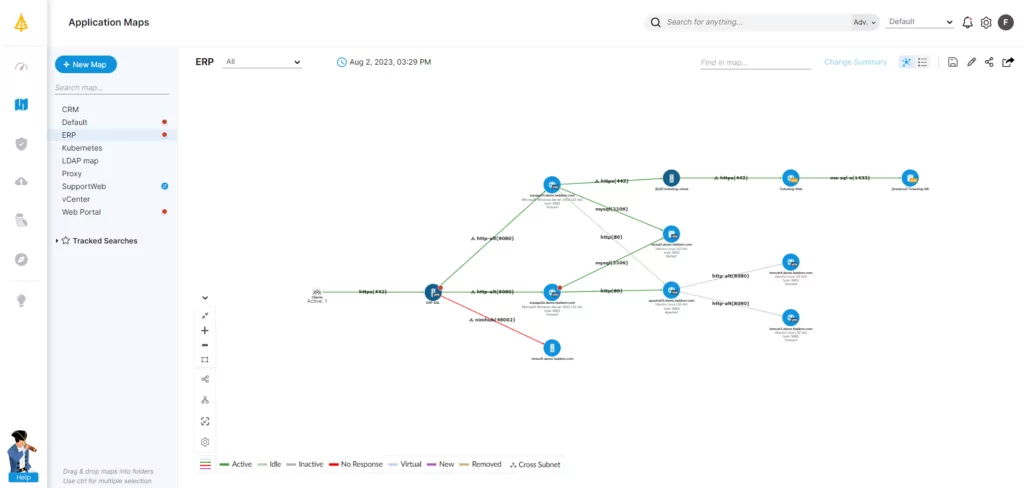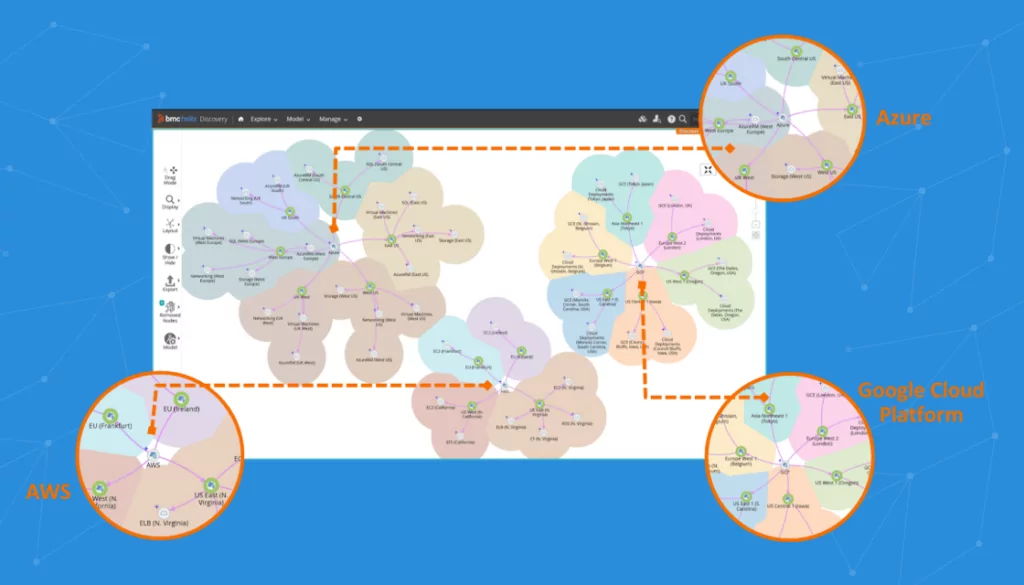What Is Application Discovery?
Without application discovery and mapping, enterprises may miss out on their share of that market value. Application discovery is the knowledge of which applications are being used in a given environment. Without this knowledge, organizations will not be positioned to use or change applications in ways that deliver any of these benefits.
Often, applications are spread across hybrid multicloud environments stretching from the data center to multiple clouds and edge, creating a complex web of dependencies. A report by MuleSoft/Deloitte states that the average enterprise uses over 900 applications. This growing complexity makes application discovery critical.
Today, IT organizations realize that reliance on the CMDB for visibility into applications is not enough. It requires a large time investment, cannot easily be updated, and offers limited transparency. Sprawling hybrid multicloud landscapes amplify these limitations. Application discovery fills this gap by identifying all applications installed across the entire IT architecture landscape.
Table of Contents
Toggle- What Is Application Discovery?
- How Does Application Dependency Mapping (ADM) Support Application Discovery?
- Benefits of Application Discovery
- Application Discovery Challenges in a Hybrid Multicloud World
- Tips from the Expert
- Approaches to Application Discovery
- Key Capabilities of an Application Discovery Solution
- Application Discovery Best Practices
- Faddom: A Single Solution for Application Discovery and Dependency Mapping
This is part of an extensive series of guides about application security
How Does Application Dependency Mapping (ADM) Support Application Discovery?
Application discovery alone does not provide all the information that the business and IT team need in order to maximize application benefits and minimize application risks and liabilities (we’ll get into that later.) This is where application dependency mapping (ADM) comes into play, which is the process used to identify all applications, their connections to and dependencies upon other applications, and their respective workloads.
Evidently, application discovery and dependency mapping have different roles and offer different benefits. To understand why both are necessary and their relationship to one another, a simple metaphor comparing applications to children can help: You may know how many children you have (discovery,) but the way to make this information valuable is by knowing what they are doing and how they are interacting both with each other and with the environment around them (dependency mapping.)
Learn more in our detailed guide to application inventory template
To put it more directly, discovery and ADM work together by providing a process of identification of all applications, their connected elements, and location. This includes all servers within the data center, across the network, in the cloud and beyond the edge. A deep dive into defining ADM shows its critical nature for every organization, and the many ways that it affects business risks, outcomes, and innovation. Understanding how discovery and ADM drive visibility gives organizations a way to see how all visibility can deliver benefits.
Related content: Read our guide to IT asset discovery
Benefits of Application Discovery
The benefits of discovery and ADM are so extensive that a complete overview is beyond the scope of this blog post! The benefits increase in scope as IT infrastructure and technology become more complex. Some of the most critical benefits include:
Facilitates Business Impact Analysis
Business impact analysis enables an organization to determine the impact of IT system and application downtime. According to Veeam, for the average business that translates to an hour or less of downtime tolerance for 56% of their high-priority applications and 49% of their normal applications. Application discovery is the foundation of this analysis, and the subsequent business continuity and disaster recovery (BCDR) strategy that ensures business operations can continue during and after a disaster.
Without first performing application discovery and ADM, organizations cannot accurately determine which applications are truly high priority (mission critical.) Discovery and ADM are also essential for determining which applications are “normal applications” versus “high priority applications.” So-called “normal applications” are less than critical, but important to ongoing business operations; this is likely measured in an acceptable downtime loss of several hours, rather than an hour or less for “high priority applications.”
Supports Change Management
From digital transformation to individual process/system changes, M&A to business restructuring, new services and products require change management to align people, processes, and technology. Application discovery and ADM work together to provide a blueprint for understanding current state processes and supporting the development of future state processes.
Enables Risk and Impact Assessment
Changes in operations, the business market, and the broader socio-economic landscape can all introduce organizational risks. The COVID-19 pandemic is one recent example of an unanticipated risk that profoundly changed many business norms, including the predominance of remote workforce collaboration, including remote application access as normative use.
Cloud migration brings with it known risks, but is nevertheless today an essential aspect of business evolution and digital transformation. Application discovery is the first step to determining the feasibility, benefits, and risks of application migration to the cloud. ADM provides the deeper details on what that migration will entail on a code level where cloud native applications and its benefits are the ideal state.
Cloud Migration
Application discovery plays a crucial role in facilitating cloud migration by helping organizations understand their current application landscape and dependencies. Gaining a comprehensive view of the applications in use, their configurations, and their relationships with underlying infrastructure is essential for successful cloud migration.
When planning a cloud migration project, organizations need to make several decisions, such as which applications to move to the cloud, the order in which they should be migrated, and the appropriate cloud service or architecture for each application. Application discovery provides the necessary information to make these decisions effectively. It helps identify applications that are suitable for migration, as well as those that may have specific performance, security, or compliance requirements that make them unsuitable for the cloud.
Understanding dependencies between applications and infrastructure is also critical during cloud migration. By mapping these relationships, organizations can develop a migration plan that takes into account the dependencies and ensures a smooth transition. Application discovery can also highlight opportunities for application modernization or refactoring during the migration process.
As organizations assess their application landscape, they may identify outdated or inefficient applications that would benefit from updates or re-architecting to take advantage of cloud-native features and services. This can result in improved performance, scalability, and cost-efficiency in the cloud environment.
Reduces Cloud Costs by Facilitating Cost Analysis
Cloud costs are always challenging for organizations, since applications in the cloud have various locations (via hybrid or multicloud) based on factors including security, regulatory compliance, elasticity, and connected services and products. Because these applications require multiple resources for different use cases, costs can fluctuate over time.
CSPs—like Azure and AWS—provide ways to support both cost analysis and application discovery. AWS Discovery Services is one way to perform application discovery and mapping across on-premises data centers and AWS cloud environments.
There are many ways that application discovery and ADM can provide benefits, such as improved application performance, maintenance, and management (operations, help desk, usage, and decommissioning.) Failure to choose the right tools for discovery can also create some challenges in a hybrid multicloud environment.
Application Discovery Challenges in a Hybrid Multicloud World
Choosing the right tools for discovery is essential in a complex, hybrid multicloud environment. Cloud strategies can deliver many benefits, but can also create various challenges for application discovery.
Limitations of Cloud Provider Native Tools
A cloud application discovery service like AWS Discovery Services or Microsoft Cloud Discovery can perform detailed discoveries across hybrid environments, but is only useful across that specific CSP environment. Organizations need a streamlined method for discovery and mapping across all CSP environments. Using multiple CSP-specific solutions and dashboards is anathema to those goals.
Dynamic Cloud Native Architectures
Organizations are constantly evaluating applications to determine how to gain the maximum benefit offered by cloud native approaches. They will usually have a mix of applications born in the cloud along with legacy monolithic on-premises applications that can benefit from a cloud-native structure. This introduces opportunities like containerization, microservices, Kubernetes, and APIs that all work to maximize application uses. The challenge is that it introduces constant changes to the application and its dependencies.
SaaS and Shadow IT Discovery
SaaS applications are a rapidly growing, permanent, but changing fixture in every organization. SaaS makes up just a portion of the application portfolio, but the average enterprise has 254 SaaS apps with only 45% regularly used, according to a Productiv report. More disturbing is that IT doesn’t manage 56% of total SaaS apps. This shows the challenge of shadow IT risks and SaaS application discovery.

Lanir specializes in founding new tech companies for Enterprise Software: Assemble and nurture a great team, Early stage funding to growth late stage, One design partner to hundreds of enterprise customers, MVP to Enterprise grade product, Low level kernel engineering to AI/ML and BigData, One advisory board to a long list of shareholders and board members of the worlds largest VCs
Tips from the Expert
In my experience, here are tips that can help you improve application discovery:
-
Combine automated tools with manual checks
Use automated tools for broad coverage and manual techniques to add context and accuracy.
-
Prioritize application dependency mapping
Document dependencies between applications and infrastructure to minimize risks during changes or migrations.
-
Focus on data accuracy and consistency
Regularly cross-check and update information to maintain a reliable inventory.
-
Categorize applications by criticality
Group applications based on importance to manage resources effectively.
-
Continuously refine discovery processes
Regularly review and improve the discovery approach for better results.
Approaches to Application Discovery
There are many ways to perform application discovery and mapping, with various tools available for the process. But as an organization’s environments, application portfolio, dependencies and data reach a certain point, most deliver only limited results. Organizations need to discover every application and its dependencies everywhere they exist, and must do so quickly and repeatedly.
The primary current methods and tools include the following:
-
- Agent and agentless for point-in-time discovery, with agentless being the preferred approach since it does not require cumbersome agent downloads to track across specific environments. Having a clear understanding of agent and agentless scanning reveals the benefits of one and the limitations of the other.
-
- Traffic Analysis of data between switches and routers can provide some level of discovery on physical servers. It has serious challenges because it is time consuming, offers no visibility into physical virtual cloud server application interactions, and requires setup for each segment of the network.
-
- The configuration management database (CMDB) has long been a source used for general application discovery among its other primary uses. IT has limitations in terms of dependency visibility and no insight into ideal versus current state, so it is impossible to be sure what is right and what is wrong about an application and its dependencies. CMDBs are also notoriously out of date in most organizations, as it takes a significant amount of time to keep it updated via its manual processes.
-
- Application discovery services like those of AWS and Microsoft Azure are very comprehensive, but as stated earlier, organizations can only use them across on-premises data centers and within that specific CSP environment.
To summarize, there are many applications discovery and ADM tools in the market, but few of them provide everything that organizations need in the age of hybrid multicloud. The best approach to vetting the right solution is to start with the structural benefits of the ideal application discovery solution. (Not that we are biased, but we recommend reading Why IT Mapping Needs an Application Dependency Mapping Tool for more.)
Key Capabilities of an Application Discovery Solution
The choice of freemium, native, and subscription/paid application discovery tools is huge. It is often easier to start by identifying what an organization wants and needs, versus looking at what many of these solutions offer. Some of the most common “must have” qualities include real-time discovery, data protection, results reporting, scalability, and value for money.
-
- Protection of an organization’s data; no data should ever leave its host environment. Ease of access and delivery to the environment is paramount, which should not require opening firewalls, presenting server credentials, or connecting to the internet. The ideal discovery solution should not access the organization’s servers or affect an on-premises or cloud environment in any way.
-
- Deployment and configuration must be automated to enable updates to the discovery process at any time. Large organizations will require agent installation for every OS instance, which is time consuming. Agentless solutions often require firewall access, server credentials, and internet connections.
-
- Results reporting should be clear and detailed, providing insights for specific actions such as cloud migrations, security, BCDR, and M&A. Without detailed analysis of discovery and dependencies, vital projects and actions are at risk.
-
- Scalability is vital as organizations and their application landscape environments grow in sometimes-unpredictable ways. The ideal is to find a provider that offers everything the organization needs both now and in the future, with a single license that minimizes costs and TCO. Some agent and agentless-based tools can cost more than $100,000 per year, and force the organization either to limit discovery to only part of the environment to contain costs, or to buy multiple licenses.
-
- Real-time application discovery and dependency mapping is a key goal—perhaps the key goal—of this whole process, entailing discovery and mapping that are continually updated and completely comprehensive.
Application Discovery Best Practices
Here are some best practices for application discovery:
-
- Use a combination of tools and techniques: Employ a mix of automated tools and manual techniques for application discovery. Automated tools can quickly gather information about applications and their dependencies, while manual techniques, such as interviews and documentation reviews, can provide valuable context and insights.
-
- Ensure data accuracy and consistency: Verify the accuracy and consistency of the discovered information to create a reliable inventory of applications and dependencies. This may involve cross-referencing data from multiple sources, updating outdated information, and resolving discrepancies.
-
- Document application dependencies: Map the dependencies between applications, as well as their relationships with underlying infrastructure components, such as servers, databases, and networks. This information is crucial for understanding the potential impact of changes or migrations and helps minimize the risk of disruptions to critical services.
-
- Prioritize and categorize applications: Classify applications based on their importance to the organization, complexity, and interdependencies. This prioritization helps focus efforts on the most critical applications and informs decision-making during migration or modernization projects.
-
- Establish a governance process: Implement a governance process to ensure that application discovery best practices are followed consistently across the organization. This process should include guidelines for data collection, documentation, and maintenance, as well as roles and responsibilities for all stakeholders.
-
- Continuously improve the discovery process: Regularly review and refine the application discovery process to identify opportunities for improvement. This may involve adopting new tools or techniques, streamlining workflows, or enhancing collaboration between stakeholders.
-
- Leverage application discovery insights: Use the insights gained from application discovery to inform decision-making and drive strategic initiatives, such as cloud migrations, application modernization, and infrastructure optimization. By doing so, you can maximize the value of your application portfolio and enhance the overall efficiency and effectiveness of your IT environment.
Learn more in our detailed guide to asset discovery tools
Faddom: A Single Solution for Application Discovery and Dependency Mapping
While AWS Application Discovery Service and Microsoft Cloud Application Discovery can deliver all these benefits, their exclusivity to their respective CSP means that organizations need multiple CSP solutions to map multicloud environments. A single solution that performs complete organizational discovery and dependency mapping—like Faddom——is a better solution in every way.
Every organization should adhere to the best practices for IT asset management to ensure that risks to the business are minimized, while opportunities and innovation can be maximized. It may be rare in the world of IT solutions, but it is possible to find an application discovery solution that delivers all these benefits with none of the downsides. Anything less will limit an organization’s resilience, growth, and bottom line. Faddom can deliver the benefits of comprehensive discovery and mapping of your hybrid and multi-cloud infrastructure quickly, cost-effectively, and securely.
Schedule a demo today to explore Faddom’s capabilities and use cases!

See Additional Guides on Key Application Security Topics
Together with our content partners, we have authored in-depth guides on several other topics that can also be useful as you explore the world of application security.
Application Migration
Authored by Faddom
- [Guide] Application Migration: Prep, Strategies & Tips for Success
- [Guide] What is IT Migration Planning?
- [Product] Faddom | Instant Application Dependency Mapping Tool
API Security
Authored by Pynt
- [Guide] API Security: Threats, Tools, and Best Practices
- [Guide] API Attacks: 6 Common Attacks and How to Prevent Them
- [Product] Pynt | Offensive API Security Testing Platform
API Security Testing
Authored by Pynt







